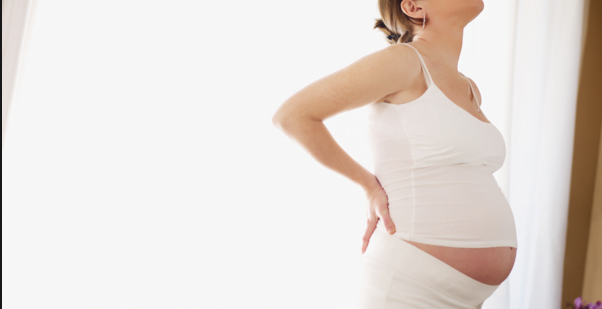
Pregnancy Causing Tailbone Pain
During pregnancy, there are substantial changes in the anatomical and mechanical forces within the mother’s body. Pregnant women typically gain a substantial amount of body weight. Many have decreased levels of overall energy, especially later in the pregnancy. These factors may result in the pregnant woman becoming more sedentary, with more time spent sitting. Sitting puts a portion of the person’s body weight directly onto the coccyx. Further, the woman’s increased abdominal weight due to the pregnancy may have her sitting posture change such that she may often sit leaning partly backward, which puts even further weight and pressure upon the tailbone. Women who may have had a pre-existing, underlying tailbone condition that was not previously causing any symptoms may now become symptomatic. For example, a woman may have years of laxity (looseness) of the joints between the coccygeal bones, or a bone spur (extra bone at the lower coccyx, causing a pointy tip that faces backward and pinches the skin when sitting leaning back). But these conditions may not have previously caused any pain or other symptoms until the pregnancy caused the additional physical, mechanical stresses onto the tailbone (due to increased weight, increased sitting and increased leaning backward while sitting). In other cases, a woman may have previously experienced a tailbone injury or other painful coccyx condition, but that condition and its symptoms may have completely resolved only to return during the current pregnancy (again, due to the additional mechanical stresses as noted above).
Further, during the later weeks of pregnancy a woman’s body creates increased levels of certain hormones that cause the ligaments within the pelvis to become more loose. Overall, this is very helpful in creating increased flexibility of the bony pelvis to prepare for and allow the baby to pass through the pelvic birth canal. However, in some patients this increased laxity may be excessive, causing ligaments at the coccyx to become too loose (lax). These excessively lax ligaments may cause the coccygeal joints to become unstable (unable to maintain normal alignment of the coccygeal bones). So, some women who have never previously had any tailbone pain or underlying tailbone condition may have new (first-time) onset of tailbone pain during pregnancy.
Now that we have addressed tailbone pain related to the pregnancy itself, we will move on to discussing the tailbone problems associated with actually giving birth.
Childbirth (Labor and Delivery) Causing Tailbone Pain
During later stages of pregnancy, women create increased levels of a hormone that causes looseness (laxity) of ligaments within the pelvis. Typically, this laxity peaks around the time of childbirth, when the woman goes into labor and delivers the baby. This is a normal and helpful process, which helps allow the baby to be born through the pelvic birth canal. However, this increased looseness of the coccygeal joints may put the mother at increased risk for injury, since the joints have lost some of their normal, protective ligamentous support. Next, when the baby moves from the mother’s abdomen down into the pelvis and through the birth canal, this places dramatically increased stresses upon the pelvis. The pelvic bones, ligaments, muscles, and tendons all are placed under these increased mechanical forces and stresses. The tailbone is not spared from these stresses.
These increased forces on the tailbone can cause tailbone fractures, dislocations, and other injuries. While the mother is pushing to deliver the baby, the mother and the medical birth team may actually hear a cracking sound as the tailbone is fractured. In some women, the angle of the tailbone is flexed too far forward, where it unfortunately causes an obstruction of the birth canal. In these cases, when the baby starts passing through the birth canal the baby’s head and body may forcefully push the tailbone out-of-the-way, causing tailbone injury. Aside from the internal mechanical forces placed upon the tailbone from within the pelvis, there are also external forces that can cause problems. During childbirth, many women in Western societies are positioned sitting leaning backward onto a reclining exam table or hospital bed. Sitting leaning backward tends to be the worst possible position for tailbone pain.
A mother with a pre-existing tailbone condition (such as a bone spur that previously was not even causing any symptoms) may become symptomatic after hours of sitting leaning backward during childbirth.
In summary, there are both internal and external mechanical forces acting upon a woman’s tailbone when she is giving birth.
Click here to order your copy of Dr. Foye’s book, Tailbone Pain Relief Now!
Patrick Foye, M.D., is Director of the Tailbone Pain Center at Rutgers New Jersey Medical School. For more information or to contact Dr Foye please visit his website located at www.TailboneDoctor.com
